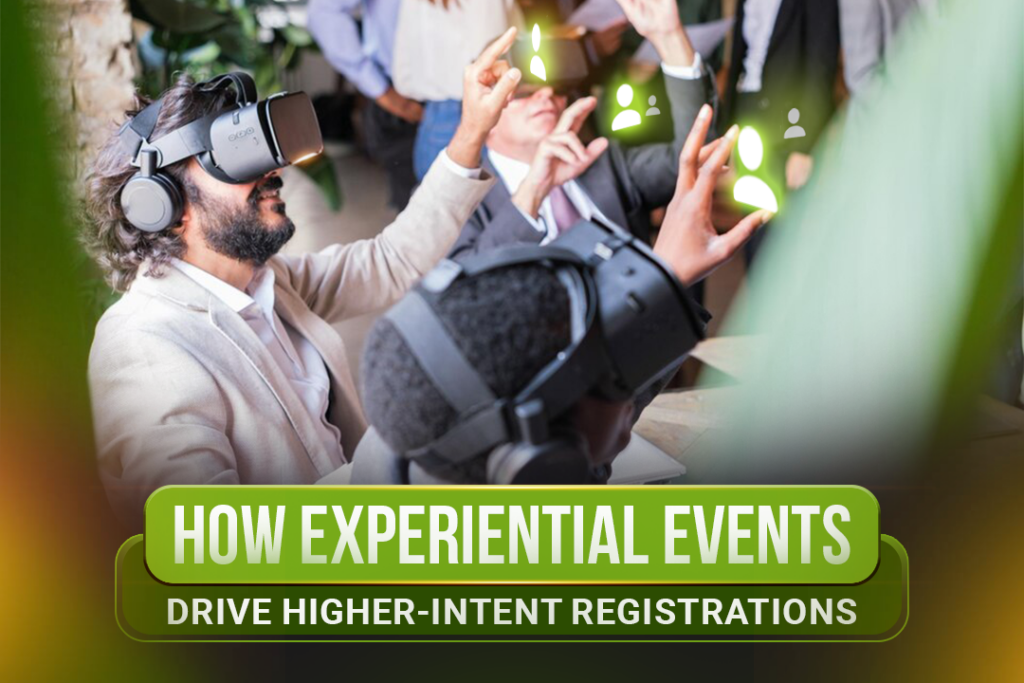
The B2B event landscape is evolving to demand more immersive and hands-on event experiences. As audience expectations change to prefer experiential events, event organizers like you must deliver those experiences by incorporating interactive sessions that provide tangible value and real-world applications for professional attendees. These experiential events attract high-intent registrants who are actively looking for practical solutions for their businesses.
Therefore, in this article, we will understand how experiential events and hands-on learning sessions drive high-intent registrations and how you can implement one.
What Are Hands-On Learning & Experiential Sessions? Why Is It Important In B2B Events?
Hands-on learning and experiential sessions are event formats where attendees actively participate rather than passively consume information. These sessions focus on practical applications of real-life problems, enabling attendees to take part in solving a problem instead of having a discourse about finding solutions to a given problem. Adding to the definition is Erin McElroy, Former Director of Executive Programs & Events at IBM and Founder of Adhesion Agency, who says in the Eventible’s Podcast, that we have paraphrased “Experiential event programs are all about allowing someone to engage all their senses of sight, audio, and emotions, to create a truly memorable experience.”.
Let’s look at some of the key characteristics of experiential events:
- Active Participation: Experiential events are designed to allow attendees to engage and interact directly with the subject matter through hands-on activities, exercises, experiments, simulations, and demonstrations.
- Real-World Applications: The core topics of these sessions revolve around a real-life problem relevant to the attendees and creating and experimenting with practical solutions that can be applied to solve a problem.
- Sensory and Interactive Elements: Unlike passive experiences, experiential events focus on providing attendees with interactive experiences through interactive audiovisual sessions, incorporating touch, movement, and interaction to enhance learning.
- Collaboration and Learning: Experiential events put a high value on hands-on learning sessions as a way to promote attendee collaboration, teamwork, group discussions, and shared problem-solving.
- Personalizations and Customization: These events provide opportunities for event organizers like you to personalize aspects of the event to cater to specific attendee needs and to enhance the overall event experience.
These characteristics allow experiential events to immerse attendees in live demonstrations, hands-on learning experiences, sensory simulations, and workshops, where they can not only discuss problems and solutions but actively participate in solving their problems through collaborative efforts. This approach greatly enhances engagement and knowledge retention and makes the overall event experience worthwhile.
Simply put, the inherent nature of experiential events, like an action-based approach, emphasis on real-life problems, multisensory experience, and personalized touch, all work to create an engaging environment for the attendees and increase knowledge retention.
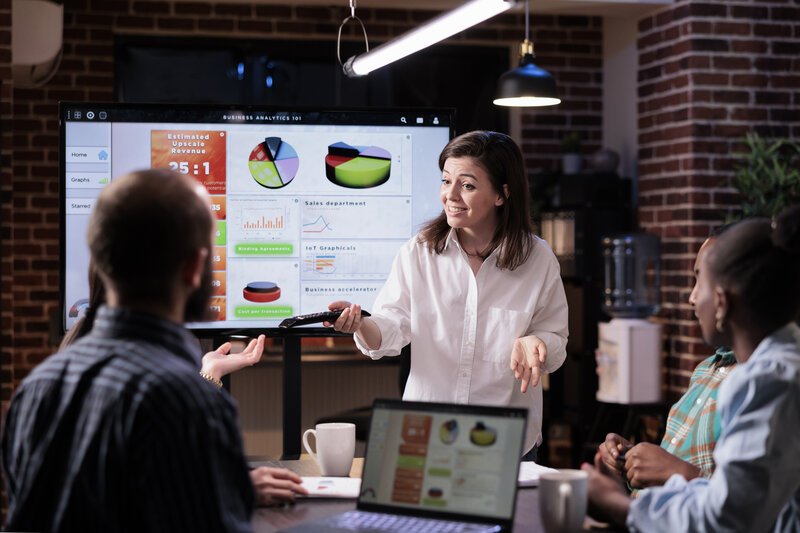
How Experiential Events Drive Higher-Intent Registrations?
Experiential events create immersive and hands-on learning experiences that engage attendees on a deeper level, leading to higher-quality registrations from professionals who are genuinely interested in what the event has to offer. In the following points, we will look at how experiential events can drive higher-intent registrations:
1. Providing Attendees with Tangible Value
As an event organizer, your biggest challenge will be to convince attendees that your event is worth their investment in terms of time, travel, and ticket cost. A simple lecture and some speaking sessions are not enough to satisfy the growing demand for a more interactive and engaging event. Attendees don’t just want a boring lecture but something tangible that they can use to solve their doubts or their problems. The need to be always unique and provide value to the attendees using interactive methods requires the adoption of experiential events.
This format can solve all these problems by providing real-world applications to solve real-world problems. You can equip attendees with tools and encourage them to actively participate and apply what they learn. Experiential events can also focus on delivering actionable takeaways, where sessions focus on practical skills and strategies that can be implemented immediately. Moreover, you can design workshops that align with the event’s value and attendees’ expectations to enhance hands-on learning. All of these approaches make experiential events a worthwhile investment for attendees, where they can satisfy their doubts and take practical solutions with them.
2. Attracting High-Intent Attendees and Serious Industry Professionals
All attendees are not equal. Every attendee has their own intention and expectation from your event. Some want networking, while others are for a casual interest. But high-intent attendees are those actively looking to invest in solutions, learn practical skills, or improve what they already know, with the ability to make strategic decisions. Experiential events appeal to high-intent attendees because the essential characteristics of this format, like the focus on real-world applications, hands-on learning, and the possibility of skill enhancement, all align with the requirements of serious industry professionals.
C-level executives and industry decision-makers prefer interactive learning sessions and seek high-value experiences that help them make important business decisions. Similarly, serious industry professionals seeking to enhance their skills prefer workshops and live training sessions. Serious buyers want proof of a product concept by attending experiential product demonstrations and live test runs. This is possible through experiential events, which is why serious industry professionals attend them, driving higher-intent registrations. This is evident in a report from Splash, which shows that formats of experiential events like brand pop-up events (49%) and community or networking events (47%) have emerged as the top drivers of customer prospects in the US.
3. Creating Emotional and Cognitive Engagement for the Attendees
Experiential events tap into audiences’ emotional and cognitive senses to enhance the level of engagement with the event. The different forms of experiential events activate multiple senses, leading to higher information retention and better emotional connection. This connection creates a positive event experience for the attendees, proven by this data from an event analytics platform, Exposure Analytics, which showed that 91% of consumers reported a more positive feeling about the brand after attending an experiential event, boosting the brand perception.
For instance, a workshop session that encourages attendees to actively participate in solving a problem by showing live solutions will have better attendee engagement than a simple lecture about solving an industry-specific problem. People learn by doing, and experiential events use this technique to ensure information is retained by the attendees so they can feel content with the event. Additionally, group activities and case studies create dynamic learning environments that trigger the cognitive faculties of attendees for faster learning. The bonds that are made in between group activities also act as an emotional connection with the event, making experiential events particularly appealing for higher-intent attendees.

4. Differentiating Your Event from Competitors
With increasing B2B events fighting for attendees’ attention, standing out and being unique is critical. Adopting experiential event formats can help you create a unique B2B event experience. According to a report from Splash, 52% of event marketers reported that experiential events drive stronger or new partnerships. You can also achieve that by designing unique hands-on activities that draw in serious professionals.
For example, you can host VIP exclusive workshops with a limited seat capacity to create urgency and exclusivity. In those workshops, you can offer attendees personalized experiences based on their interests. Furthermore, integrating AR/VR technology will enable you to deliver engaging and interactive experiences, making your event memorable and unique.
5. Increasing Likelihood for Conversion
Beyond registrations, experiential events also lead to more substantial post-event conversion rates in the form of product purchases, partnerships, or continued engagement. According to Pixperience, an event experience platform, 85% of attendees are more likely to purchase a product or service after attending a live marketing event (a format of experiential event). This is mainly because attendees are more likely to invest in solutions they’ve tested and seen come to fruition. The faith that comes from these kinds of solutions leads to increased conversions.
Experiential events also foster long-term business relationships using interactive sessions. An event with a strong focus on collaboration and live product demonstrations creates an ecosystem where attendees can work together and make connections easily, creating fruitful networking opportunities. Similarly, experiential events also increase the likelihood of a good review or feedback because the memory of the event is more vivid.
Why Experiential Events Should Be Part Of Your B2B Event Strategy?
B2B events are more effective when they offer attendees hands-on learning experiences for real-world problems. Experiential events trigger the emotional and cognitive aspects of the attendees by providing interactive sessions that focus on active participation. This approach creates an emotional connection with the event, increasing the likelihood of conversions. As evidenced by the data from another event experience platform, Explore, 70% of attendees become repeat customers after participating in an experiential event, underscoring the strategic importance of experiential events. Moreover, it also allows them to give insightful reviews of the event, which acts as social proof for event organizers like you to improve and promote the event further.
Overall, experiential events are appealing to attendees, driving higher-intent registrations. The rapid growth and popularity of experiential events are evident in the positive reviews that attendees have posted on event review platforms like Eventible. This platform verifies all reviews to evaluate their authenticity, which would increase the credibility of the reviews.
The following are some event review examples from Eventible that show the growing popularity of experiential events, how they can improve the overall attendee experience, and why experiential events should be part of your B2B event strategy:
Example 1: ATD TK 2024
An attendee named Krysta Bennett, Instructional Designer from Sherwin-Williams, praised the event for innovative strategies and creative ways to approach learning:
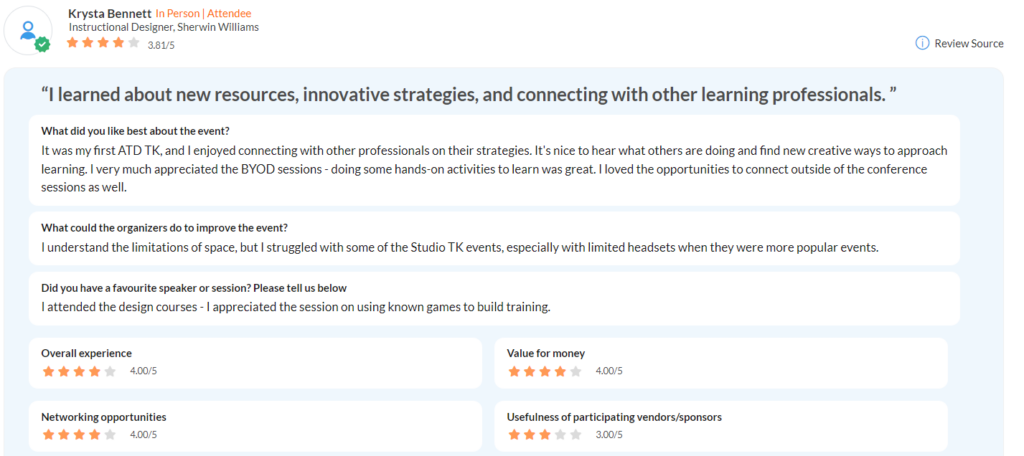
The reviewer appreciated the hands-on learning experience offered by the ATD TK 2024 event, which also allowed her to connect with other professionals on their strategies. This shows how adopting hands-on sessions and experiential learning can provide attendees with real-life applications for their businesses and act as a networking opportunity.
Example 2: Rev_Tech Summit 2024
Another attendee, Bryan Heimberg, Senior Program Manager at SteamForce Solutions, acknowledged the seamless integration of virtual platforms, engaging content, and interactive sessions:
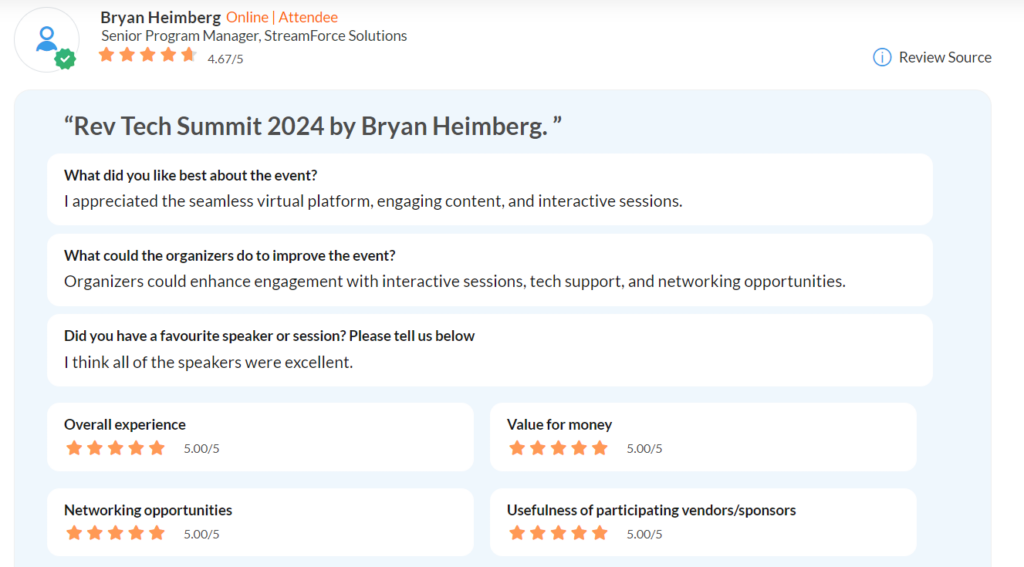
This review highlights how incorporating the basic elements of experiential events, like interactive sessions and engaging content, can help attendees connect with the event at an emotional level, increasing the chances of high-intent registrations.
How To Implement A High-Intent Registration Strategy Using Experiential Events?
Now that we know how experiential events drive high-intent registrations and are crucial for maintaining attendee engagement, it’s time to understand how you can implement a high-intent registration strategy using experiential events:
1. Designing Compelling Hands-on Workshops
The success of experiential events relies on offering high-value, engaging sessions beyond conventional presentations. Your job as an event organizer trying to attract high-intent participants is hosting hands-on workshops where attendees can apply concepts in real time to real-world problems. The workshop design should encourage active participation from attendees in a value-added way. For example, you can feature live training sessions using AI-driven marketing tools for an AI-focused B2B event.
Furthermore, you can incorporate interactive live demonstrations to showcase your sponsors’ cutting-edge innovations. Whether it’s a fintech software or manufacturing automation, you can plan your sessions to allow them to demonstrate their innovations using live demonstrations, AR/VR tools, and interactive presentations. Utilize interactive panels for speaker sessions that can show live captions of the sessions for a better user experience. The panels can also feature live Q&A sessions, live polling, and problem-solving activities, making a simple discussion more dynamic and valuable.
2. Incentivizing Early Registrations
Creating a sense of urgency can increase early registration numbers for your B2B event while ensuring that the most engaged and high-intent professionals secure their seats. You can do that by offering exclusive access to VIP experiential sessions to high-intent professionals. These sessions can include small-group-led innovation labs or behind-the-scenes product testing. Moreover, you can offer one-on-one mentoring sessions with industry experts that are exclusively available for early registrants. Limited-seat masterclasses or certifications would also be a good offer for these attendees.
Overall, you must create pathways to attract high-intent attendees for your B2B event and drive early registration numbers. These pathways must be substantial enough to give them value for their time and money.

3. Encouraging Past Attendees to Leave Reviews
High-intent professionals and serious attendees trust peer recommendations and real testimonials rather than simple ads. As such, you should encourage your attendees to share their event experiences on an event review platform, like Eventible.
Start by automating a post-event survey or feedback form pop-up on their event apps to encourage attendees to give reviews. You can then showcase the positive reviews as social proof and build credibility for the event, boosting future registrations. Design your survey questions to gain answers related to the experiential nature of the event and how the hands-on sessions provided real-world benefits. This will enable you to improve your future event-organizing efforts.
How Are Top B2B Brands Using Experiential Events to Drive High-Intent Registrations?
Now that we know how experiential has become a cornerstone in the B2B event industry, driving high-intent registrations by immersing attendees in experiential, engaging, and hands-on experiences, let’s look at some recent cases of how some of the top B2B brands have used innovative approaches to experiential events:
Case Study 1: Hubspot’s INBOUND Conference
Hubspot’s annual INBOUND Conference is known for its unique blend of education, product demonstrations, and community engagement. The conference leverages the core aspects of experiential events by providing interactive booths where attendees can engage with Hubspot’s software, participate in hands-on workshops, and attend breakout sessions that facilitate networking with industry professionals. This multidimensional approach not only educates attendees but also fosters a sense of community while engaging all senses, thereby also creating an emotional connection with the event.
Case Study 2: Adobe Max Conference
Adobe’s annual Max Conference attracts creative professionals around the world to explore the latest innovations in Adobe’s technology and tools. The event features hands-on workshops, celebrity speakers, and interactive audio-visual presentations that allow attendees to interact directly with Adobe products. This immersive approach enhances the creative skills of attendees while deepening their connection with the Adobe ecosystem, driving higher-intent registration, and fostering a community of brand advocates.
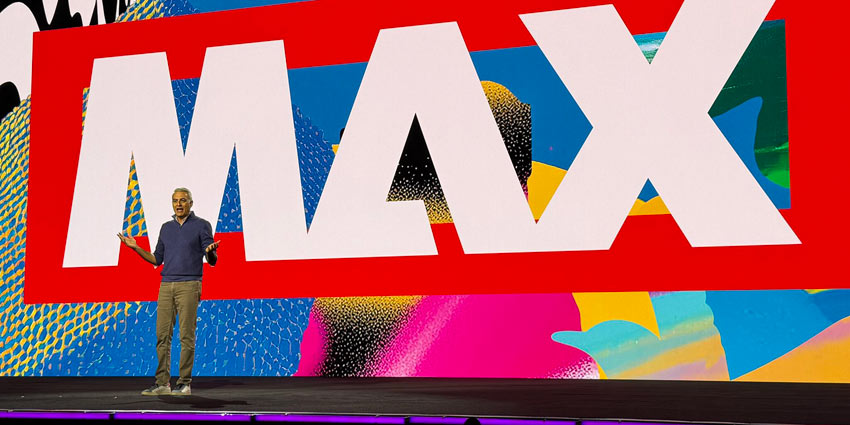
Case Study 3: Salesforce’s Dreamforce Event
Salesforce’s Dreamforce is a flagship event that embodies the company’s “Ohana” culture of inclusivity and community. As such, Salesforce has designed its event to be as attendee-centric or customer-centric as possible by encouraging active participation from clients in the form of customer-driven sessions where clients can share stories, participate in hands-on workshops using Salesforce products, and join other creative engagements. By creating an environment where attendees shape their own event experience and have an active hand in every activity, in the form of interacting with the product and sharing stories, Salesforce has effectively strengthened its emotional connection with its brand, thus increasing higher-intent registrations and improving brand loyalty.
Key Takeaway
Experiential events are crucial to drive high-intent registrations because they offer attendees valuable information that they’re able to retain while also allowing you to maintain the uniqueness of your event. The very nature of experiential events attracts high-intent attendees, business professionals, and industry experts because they get real-world knowledge all while having a good experience. This translates into positive reviews, thus driving future registration numbers.
If you want to learn more about B2B events and how to create an engaging event experience, visit Eventible to learn more.


Comments are closed.